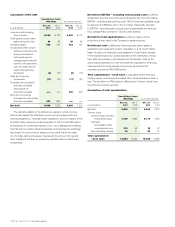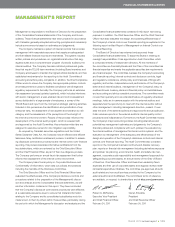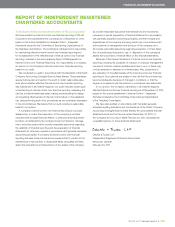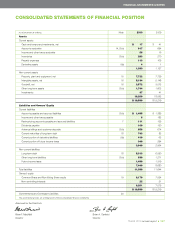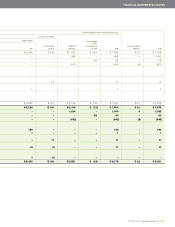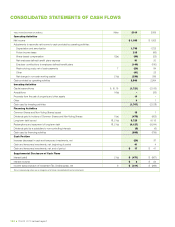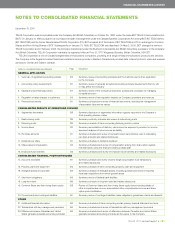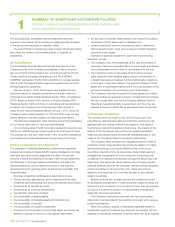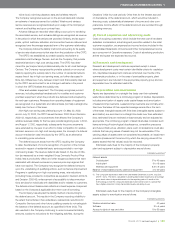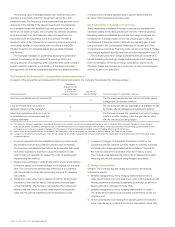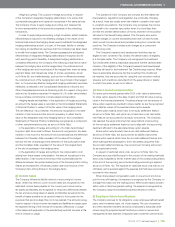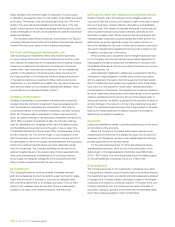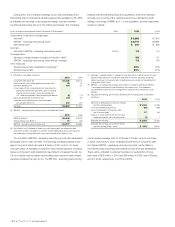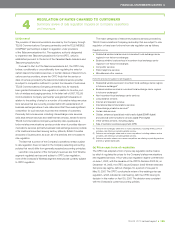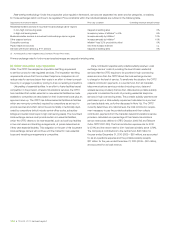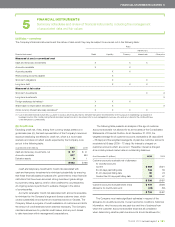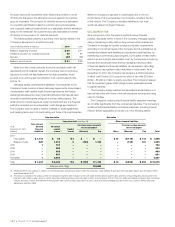Telus 2010 Annual Report Download - page 126
Download and view the complete annual report
Please find page 126 of the 2010 Telus annual report below. You can navigate through the pages in the report by either clicking on the pages listed below, or by using the keyword search tool below to find specific information within the annual report.
122 . TELUS 2010 annual report
.the accruals for Canadian Radio-television and Telecommunications
Commission (CRTC) deferral account liabilities; and
.certain actuarial and economic assumptions used in determining
defined benefit pension costs, accrued pension benefit obligations
and pension plan assets.
Examples of significant judgements, apart from those involving
estimation, include:
.The Company’s view that substantially all the risks and rewards of
ownership of accounts receivable sold to an arm’s-length securitization
trust, as discussed further in Note 14, are transferred to the trust.
.The Company’s choice to depreciate and amortize its property,
plant, equipment and intangible assets subject to amortization on
a straight-line basis as it believes that this method better reflects the
consumption of resources related to the economic lifespan of those
assets than an accelerated method and is more representative of the
economic substance of the underlying use of those assets.
.The Company’s view that its spectrum licences granted by Industry
Canada will likely be renewed by Industry Canada; that the Company
intends to renew them; and that the Company believes it has the
financial and operational ability to renew them and, thus, they are
deemed to have an indefinite life, as discussed further in Note 16(c).
(c) Revenue recognition
The Company earns the majority of its revenue (voice local, voice
long distance, data (including data and information technology man
-
aged services) and wireless network) from access to, and usage of,
the Company’s telecommunications infrastructure. The majority of the
balance of the Company’s revenue (other and wireless equipment)
arises from providing products and services facilitating access to, and
usage of, the Company’s telecommunications infrastructure.
The Company offers complete and integrated solutions to meet its
customers’ needs. These solutions may involve the delivery of multiple
services and products occurring at different points in time and/or
over different periods of time. As appropriate, these multiple element
arrangements are separated into their component accounting units,
consideration is measured and allocated amongst the accounting units
based upon their relative fair values (derived using Company-specific
objective evidence) and then the Company’s relevant revenue recognition
policies are applied to the accounting units. Lease accounting is
applied to an accounting unit if it conveys the right to use a specific
asset to a customer.
Multiple contracts with a single customer are normally accounted
for as separate arrangements. In instances where multiple contracts are
entered into with a customer in a short period of time, they are reviewed
as a group to ensure that, similar to multiple element arrangements,
relative fair values are appropriate.
The Company’s revenues are recorded net of any value-added,
sales and/or use taxes billed to the customer concurrent with a revenue-
producing transaction.
When the Company receives no identifiable, separable benefit for
consideration given to a customer (e.g. discounts and rebates), the con-
sideration is recorded as a reduction of revenue rather than as an expense.
The accompanying consolidated financial statements have been
prepared in accordance with accounting principles generally accepted
in Canada and are expressed in Canadian dollars.
The terms TELUS or Company are used to mean TELUS Corporation
and, where the context of the narrative permits, or requires, its
subsidiaries.
(a) Consolidation
The consolidated financial statements include the accounts of the
Company and all of the Company’s subsidiaries, of which the princi-
pal one is TELUS Communications Inc. Currently, through the TELUS
Communications Company partnership and the TELE-MOBILE
COMPANY partnership, TELUS Communications Inc. includes substan-
tially all of the Company’s Wireline segment’s operations and all of the
Wireless segment’s operations.
Effective January 1, 2009, the Company early adopted the new
recommendations for business combinations (Canadian Institute of
Chartered Accountants (CICA) Handbook Section 1582), consolidations
(CICA Handbook Section 1601) and non-controlling interests (CICA
Handbook Section 1602) and did so in accordance with the transitional
provisions; the Company would otherwise have been required to
adopt the new recommendations effective January 1, 2011. During the
Company’s years ended December 31, 2010 and 2009, it was not signi-
ficantly affected by the early adoption of these recommendations.
The financing arrangements of the Company and all of its subsidiaries
do not impose restrictions on inter-corporate dividends.
On a continuing basis, TELUS Corporation reviews its corporate orga-
nization and effects changes as appropriate so as to enhance its value.
This process can, and does, affect which of the Company’s subsidiaries
are considered principal subsidiaries at any particular point in time.
(b) Use of estimates and judgements
The preparation of financial statements in conformity with generally
accepted accounting principles (GAAP) requires management to make
estimates, assumptions and judgements that affect: the reported
amounts of assets and liabilities at the date of the financial statements;
the disclosure of contingent assets and liabilities at the date of the
financial statements; and the reported amounts of revenues and
expenses during the reporting period. Actual results could differ from
those estimates.
Examples of significant estimates and assumptions include:
.the key economic assumptions used to determine the fair value
of residual cash flows arising from accounts receivable securitization;
.the allowance for doubtful accounts;
.the allowance for inventory obsolescence;
.the estimated useful lives of assets;
.the recoverability of tangible assets;
.the recoverability of intangible assets with indefinite lives;
.the recoverability of goodwill;
.the recoverability of long-term investments;
.the amount and composition of income tax assets and income tax
liabilities, including the amount of unrecognized tax benefits;
1SUMMARY OF SIGNIFICANT ACCOUNTING POLICIES
Summary review of accounting principles and the methods used
in their application by the Company


